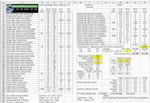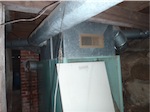Now that summer has come to an end, fall is right around the corner and we begin to think about winterizing garden tools, and chemicals for next year’s gardening season. As many of us move toward more earthfriendly ways of gardening it has become necessary for us not to forget that improperly stored chemicals can have lethal consequences. Here are a few tips to help you make sure your chemical winterizing safe.
Always read and follow the storage instructions listed on the label.
Keep the Poison Control number handy at all time. I keep mine on my phone, and a copy on the refrigerator door.
You should always store pesticides in the original containers with all the proper identification of the contents. DO NOT remove the labels on pesticide containers as they often included information of what to do if accidental poisoning takes place.
Keep pesticides out the reach of children, preferable in a locked closed or on a high shelf out of reach.
Don’t hoard chemicals, purchase only what you need for the season or specific treatment.
Never transfer pesticides to soft drink bottles or other containers including plastic milk, juice or coffee cans. They could be mistaken for something to eat or drink.
When in doubt as to the identity of a product or container DON’T USE IT. When in doubt throw it out!
Be responsible and discard all chemicals properly and not down the storm drain.
Fall Garden Chores
In Texas with its lovely fall weather, it is hard to think of preparing our flower beds and garden for winter. However, it is easier to start now than doing it on a cold day or even trying to do in spring when you are wanting to plant. Having an established plan will make gardening much more pleasant and easier.
Trees and Shrubs: Make sure you clean out debris from around the trunks so as not to provide a winter home for rodents and other pests. Keep the plants watered well and as it will be easier for them to go through a freeze if they have plenty of moisture. Look for dead limbs or other areas that will need pruning once they have lost their leaves and gone dormant. After the leaves are gone would be a good time to select prune crape myrtles of ONLY branches that rub together, grow to the middle or are broken. DO NOT TOP THEM!
If you are thinking of planting a new tree or shrubs, the best time is after they have lost their leaves. It will give the root system time to develop over the winter that will stand up to the Texas heat next summer.
Flower beds: Select deadheading of perennials and annuals can be done now if you want to save seeds for next year. Plants that provide a winter interest or food for birds, such as coneflowers, can be left until later. Clean any debris from around plants that might overwinter pests or diseases. It is especially necessary for roses that any debris be removed to prevent black spot or other fungus and daylilies to prevent rust. Cannas, elephant ears and other frost ten- der plants need to be cut back to ground level after first light frost.
Spring bulbs can be planted now. Drop a little plant food in the hole as you plant them. Remember the pointed side up. Believe it or not, I once had a friend plant her entire bed with the pointed end down. If not done in October, you can still plant in November. They can still be planted after that but the flower production may be diminished.
Any beds that are thick with weeds can be covered with cardboard or a thick layer of newspaper and then covered with a thick layer of mulch. When spring planting time comes you can just dig down and plant right through the covering. Newspaper makes a great weed barrier any time and will decompose during the planting season. No supply of newspaper? Stacks of old newspapers can be purchased from the newspaper office at an inexpensive price.
Lawns: If possible leave the last mowing clippings on the lawn so they can decompose over the winter. Do not leave the leaves on the grass as they can prevent moisture and light from getting through and kill the grass. If you do not have room for a compose pile, mulch them with the lawnmower and put them in a large, plastic trash bag. Wet them down and tie up but leave loose enough that rain can get in and then punch holes in bottom and round sides. If kept moist by spring time the worms should have provided you with rich compose for your plants.
When the winter days are cold or rainy days you can be snug indoors knowing that your fall efforts have made the garden and flower beds ready and waiting for the next growing season.
- Home
- Blog
- Forum
- Green Home Topics

- »Healthy Home
- »Water Conservation
- »Energy Efficiency
- »Materials & Products
- »Resources
- Videos
- »From the Experts
- Remodeling with Passive House Approach
- How to Choose an Advanced Water Heater
- Choosing A Whole-House Ventilation System
- Selecting High Performance Windows
- Toward Zero Energy at Home - A Personal Example
- Remodel to Passive House Standards
- An Introduction to Ecological Landscaping
- Weingarten House at San Benancio - Energy
- A Deep Energy Retrofit Project
- Directory
- Events/News

- Shop
- About Us





